Abstract
1. Previous theoretical studies have led to the predictions that, in the dog, the parasternal intercostal muscles in the rostral interspaces shorten more during passive inflation than those in the caudal interspaces and have, therefore, a greater inspiratory mechanical advantage. The present studies were undertaken to test these predictions. 2. The effects of passive inflation on the length of the parasternal intercostals interspaces 1 to 7 were evaluated with markers implanted in the costal cartilages. Although the muscles in all interspaces shortened with passive inflation, the fractional shortening increased from the first to the second and third interspaces and then decreased continuously to the seventh interspace. 3. To understand this peculiar distribution, a geometric model of the parasternal area was then developed and a relation was obtained between muscle shortening and the angles that describe the orientation of the muscle and costal cartilage relative to the sternum. Measurement of these angles indicated that the rostrocaudal gradient of parasternal shortening resulted from the different orientations of the costal cartilages and their different rotations during passive inflation. 4. The changes in airway pressure generated by the parasternal intercostals in interspaces 3, 5 and 7 were finally measured during selective, maximal stimulation. The fall in pressure was invariably greatest during contraction of the third interspace and smallest during contraction of the seventh. 5. These observations indicate that, in the dog, the rostrocaudal gradient in rib rotation induces a rostrocaudal gradient of mechanical advantage in the parasternal intercostals, which has its climax in the second and third interspaces. These observations also support the concept that the respiratory effect of a given respiratory muscle can be computed from its behaviour during passive inflation.
Full text
PDF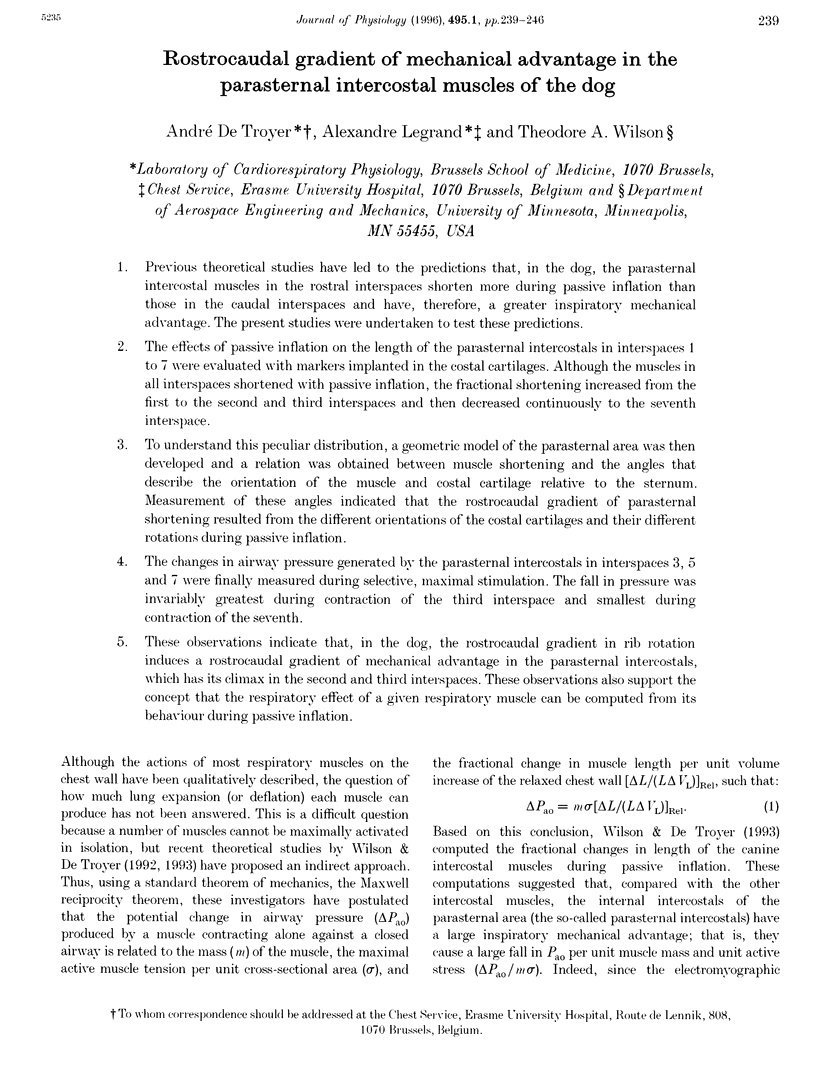
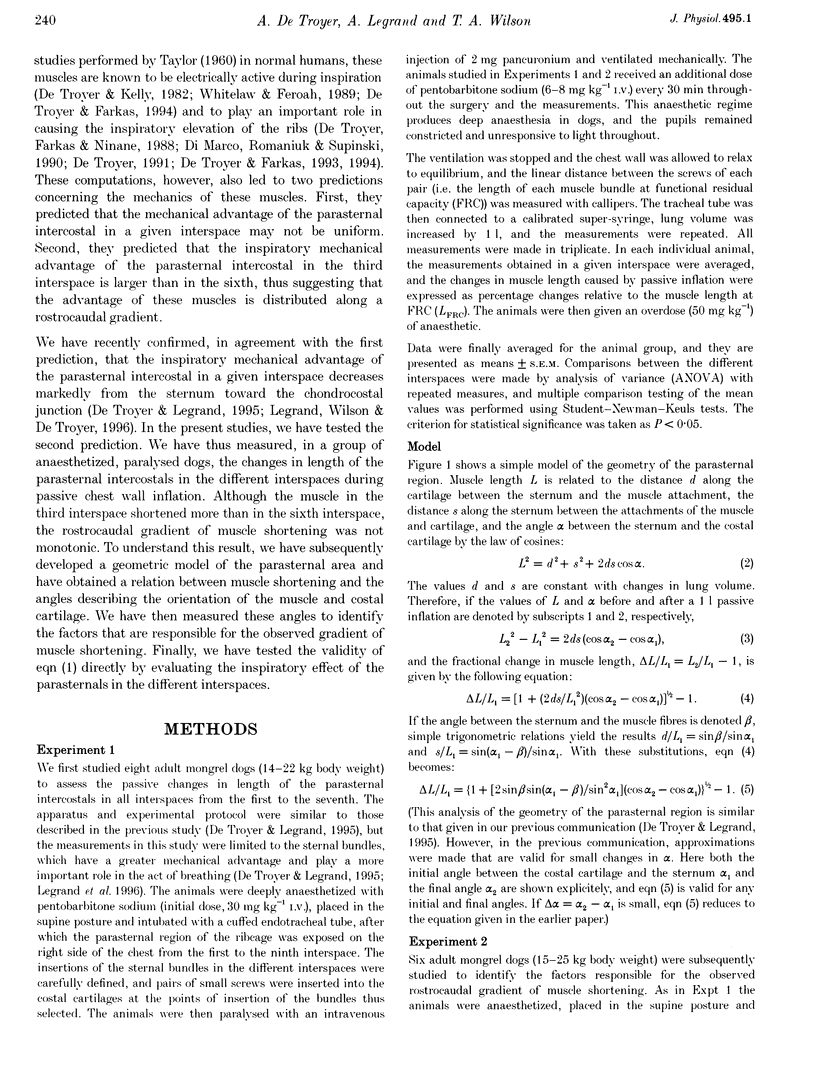
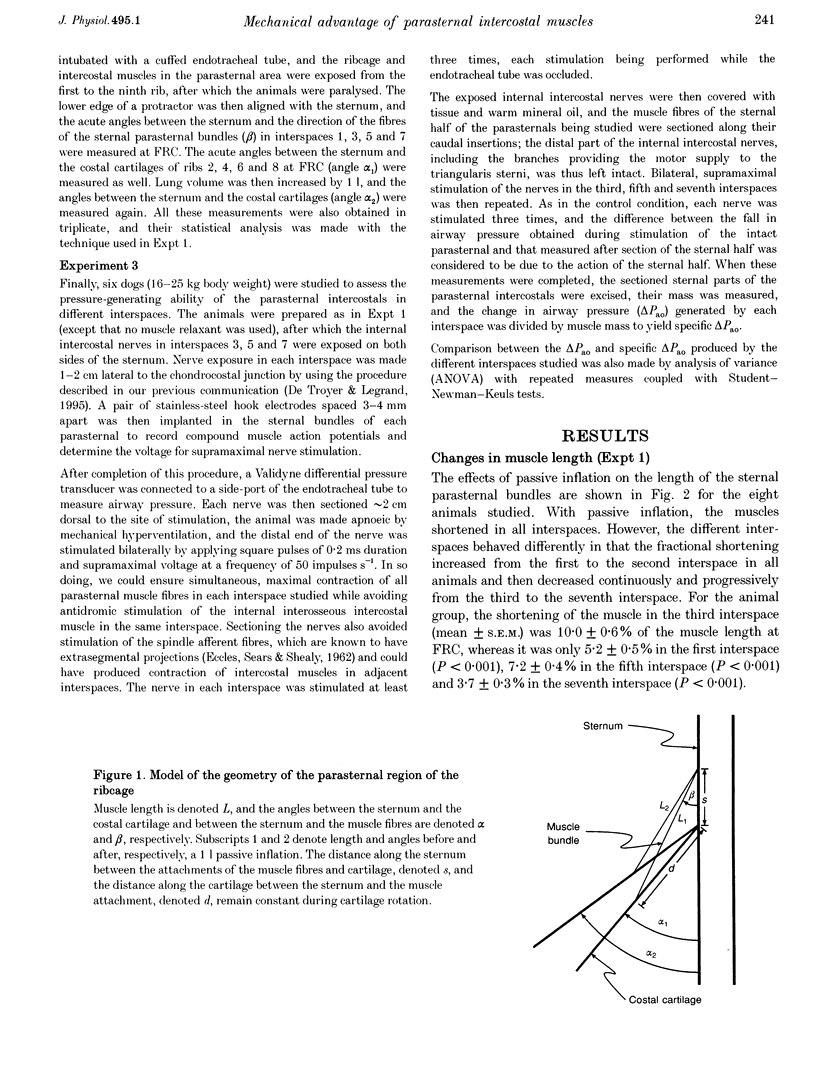
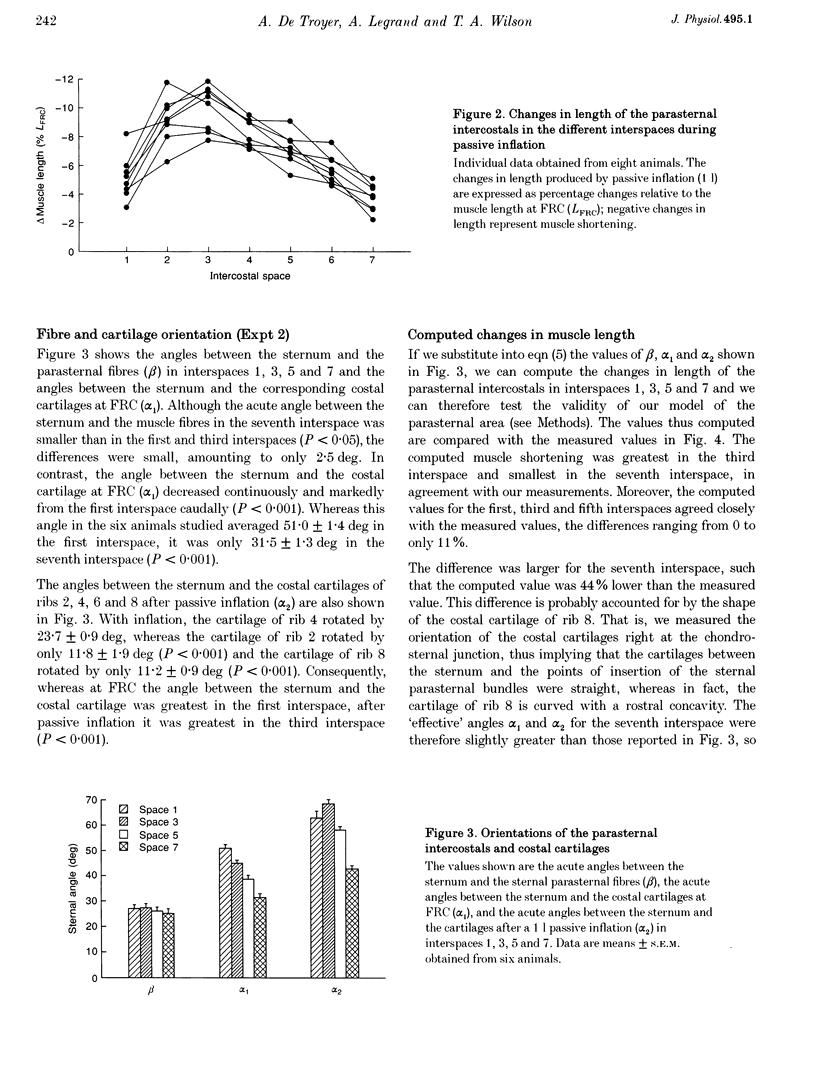
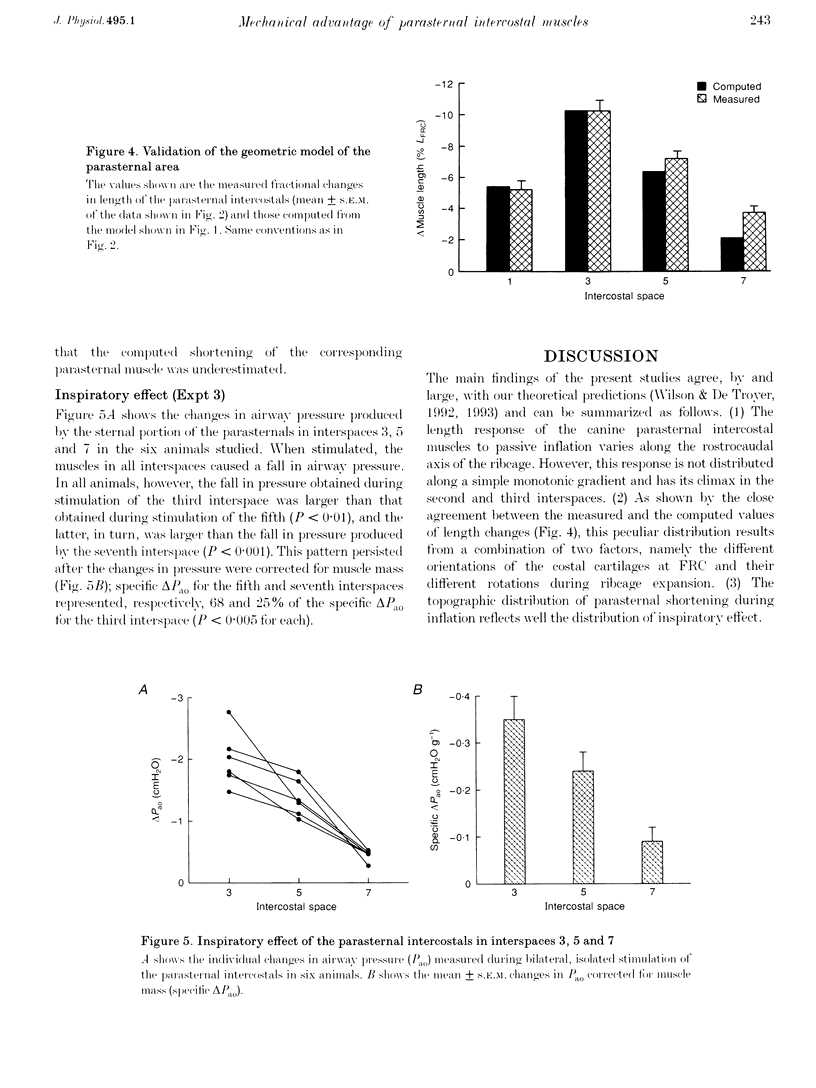
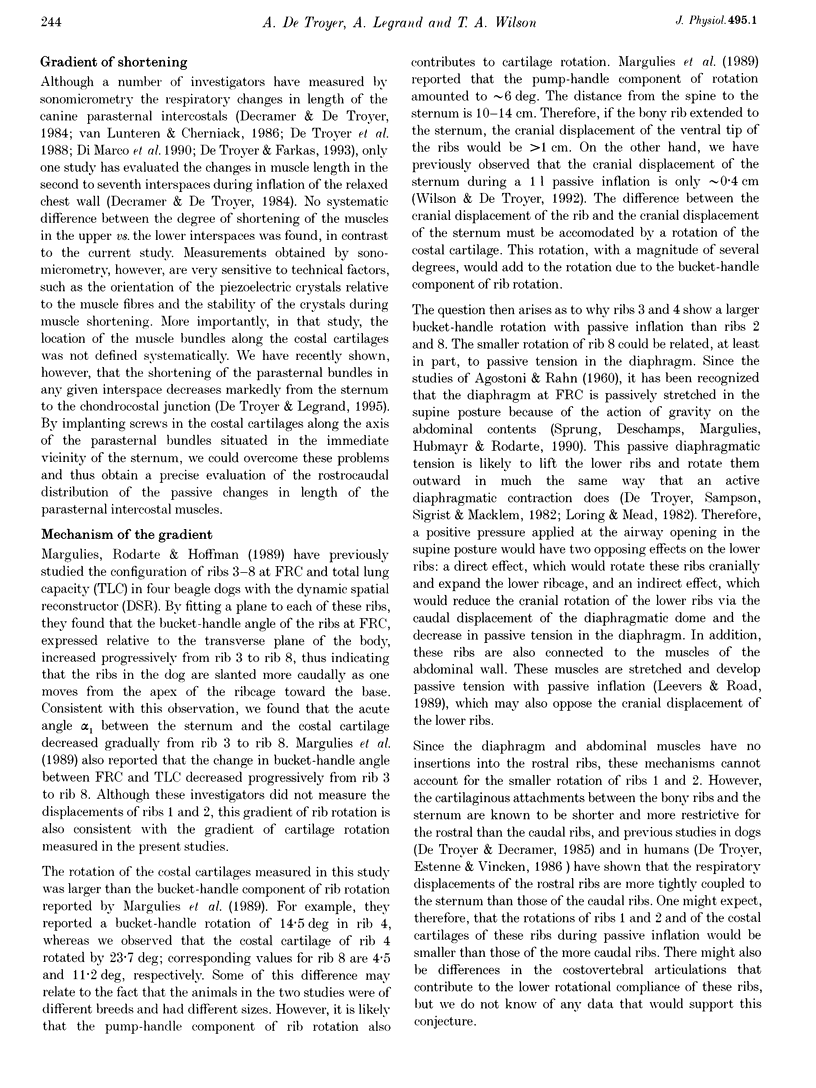
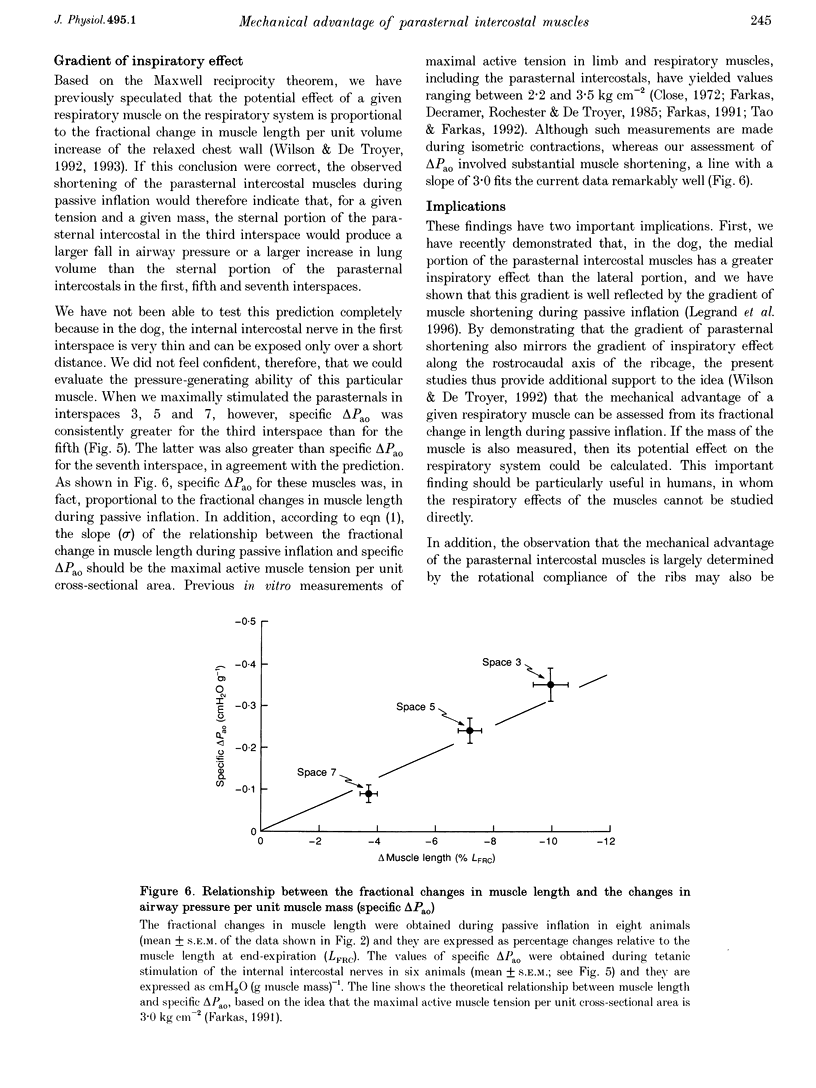
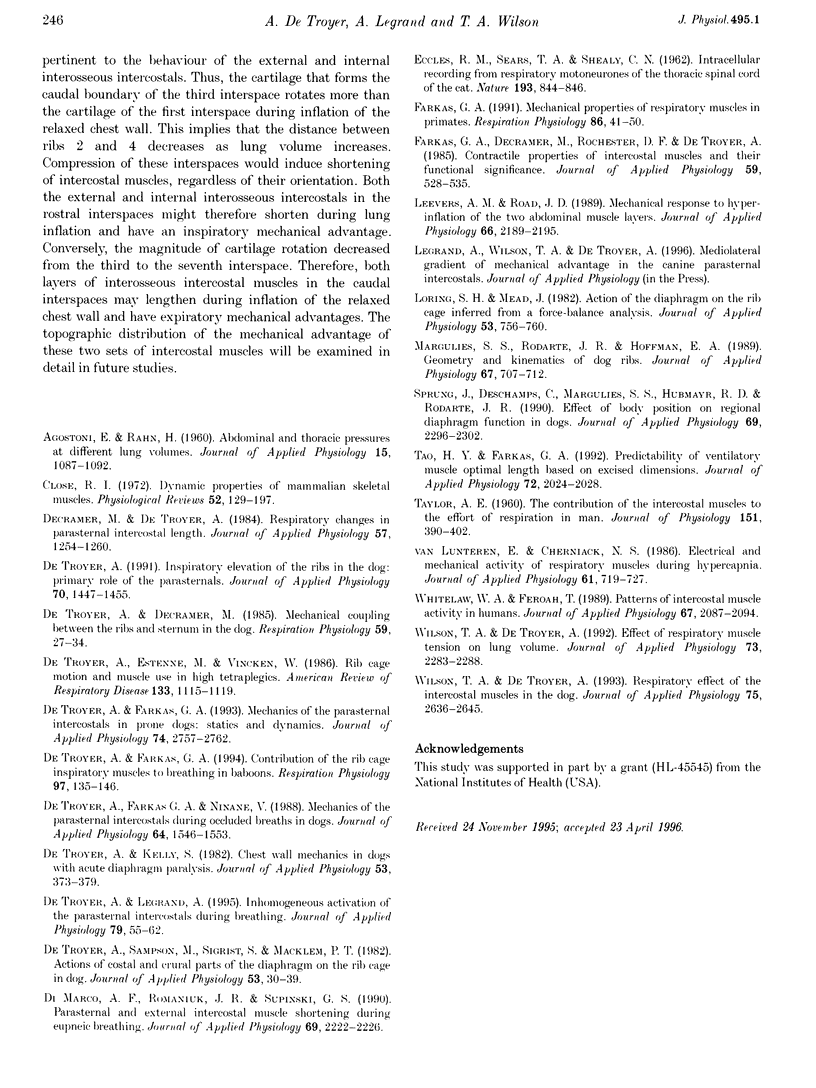
Selected References
These references are in PubMed. This may not be the complete list of references from this article.
- AGOSTONI E., RAHN H. Abdominal and thoracic pressures at different lung volumes. J Appl Physiol. 1960 Nov;15:1087–1092. doi: 10.1152/jappl.1960.15.6.1087. [DOI] [PubMed] [Google Scholar]
- Close R. I. Dynamic properties of mammalian skeletal muscles. Physiol Rev. 1972 Jan;52(1):129–197. doi: 10.1152/physrev.1972.52.1.129. [DOI] [PubMed] [Google Scholar]
- De Troyer A., Decramer M. Mechanical coupling between the ribs and sternum in the dog. Respir Physiol. 1985 Jan;59(1):27–34. doi: 10.1016/0034-5687(85)90015-5. [DOI] [PubMed] [Google Scholar]
- De Troyer A., Estenne M., Vincken W. Rib cage motion and muscle use in high tetraplegics. Am Rev Respir Dis. 1986 Jun;133(6):1115–1119. doi: 10.1164/arrd.1986.133.6.1115. [DOI] [PubMed] [Google Scholar]
- De Troyer A., Farkas G. A., Ninane V. Mechanics of the parasternal intercostals during occluded breaths in dogs. J Appl Physiol (1985) 1988 Apr;64(4):1546–1553. doi: 10.1152/jappl.1988.64.4.1546. [DOI] [PubMed] [Google Scholar]
- De Troyer A., Farkas G. Mechanics of the parasternal intercostals in prone dogs: statics and dynamics. J Appl Physiol (1985) 1993 Jun;74(6):2757–2762. doi: 10.1152/jappl.1993.74.6.2757. [DOI] [PubMed] [Google Scholar]
- De Troyer A. Inspiratory elevation of the ribs in the dog: primary role of the parasternals. J Appl Physiol (1985) 1991 Apr;70(4):1447–1455. doi: 10.1152/jappl.1991.70.4.1447. [DOI] [PubMed] [Google Scholar]
- De Troyer A., Kelly S. Chest wall mechanics in dogs with acute diaphragm paralysis. J Appl Physiol Respir Environ Exerc Physiol. 1982 Aug;53(2):373–379. doi: 10.1152/jappl.1982.53.2.373. [DOI] [PubMed] [Google Scholar]
- Decramer M., De Troyer A. Respiratory changes in parasternal intercostal length. J Appl Physiol Respir Environ Exerc Physiol. 1984 Oct;57(4):1254–1260. doi: 10.1152/jappl.1984.57.4.1254. [DOI] [PubMed] [Google Scholar]
- ECCLES R. M., SEARS T. A., SHEALY C. N. Intra-cellular recording from respiratory motoneurones of the thoracic spinal cord of the cat. Nature. 1962 Mar 3;193:844–846. doi: 10.1038/193844a0. [DOI] [PubMed] [Google Scholar]
- Farkas G. A., Decramer M., Rochester D. F., De Troyer A. Contractile properties of intercostal muscles and their functional significance. J Appl Physiol (1985) 1985 Aug;59(2):528–535. doi: 10.1152/jappl.1985.59.2.528. [DOI] [PubMed] [Google Scholar]
- Farkas G. A. Mechanical properties of respiratory muscles in primates. Respir Physiol. 1991 Oct;86(1):41–50. doi: 10.1016/0034-5687(91)90038-k. [DOI] [PubMed] [Google Scholar]
- Leevers A. M., Road J. D. Mechanical response to hyperinflation of the two abdominal muscle layers. J Appl Physiol (1985) 1989 May;66(5):2189–2195. doi: 10.1152/jappl.1989.66.5.2189. [DOI] [PubMed] [Google Scholar]
- Loring S. H., Mead J. Action of the diaphragm on the rib cage inferred from a force-balance analysis. J Appl Physiol Respir Environ Exerc Physiol. 1982 Sep;53(3):756–760. doi: 10.1152/jappl.1982.53.3.756. [DOI] [PubMed] [Google Scholar]
- Margulies S. S., Rodarte J. R., Hoffman E. A. Geometry and kinematics of dog ribs. J Appl Physiol (1985) 1989 Aug;67(2):707–712. doi: 10.1152/jappl.1989.67.2.707. [DOI] [PubMed] [Google Scholar]
- Sprung J., Deschamps C., Margulies S. S., Hubmayr R. D., Rodarte J. R. Effect of body position on regional diaphragm function in dogs. J Appl Physiol (1985) 1990 Dec;69(6):2296–2302. doi: 10.1152/jappl.1990.69.6.2296. [DOI] [PubMed] [Google Scholar]
- TAYLOR A. The contribution of the intercostal muscles to the effort of respiration in man. J Physiol. 1960 May;151:390–402. doi: 10.1113/jphysiol.1960.sp006446. [DOI] [PMC free article] [PubMed] [Google Scholar]
- Tao H. Y., Farkas G. A. Predictability of ventilatory muscle optimal length based on excised dimensions. J Appl Physiol (1985) 1992 May;72(5):2024–2028. doi: 10.1152/jappl.1992.72.5.2024. [DOI] [PubMed] [Google Scholar]
- Whitelaw W. A., Feroah T. Patterns of intercostal muscle activity in humans. J Appl Physiol (1985) 1989 Nov;67(5):2087–2094. doi: 10.1152/jappl.1989.67.5.2087. [DOI] [PubMed] [Google Scholar]
- Wilson T. A., De Troyer A. Effect of respiratory muscle tension on lung volume. J Appl Physiol (1985) 1992 Dec;73(6):2283–2288. doi: 10.1152/jappl.1992.73.6.2283. [DOI] [PubMed] [Google Scholar]
- van Lunteren E., Cherniack N. S. Electrical and mechanical activity of respiratory muscles during hypercapnia. J Appl Physiol (1985) 1986 Aug;61(2):719–727. doi: 10.1152/jappl.1986.61.2.719. [DOI] [PubMed] [Google Scholar]


